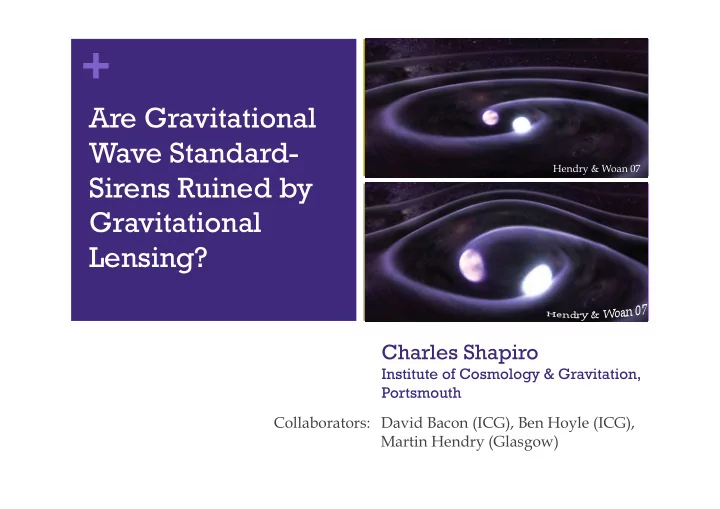

+ Are Gravitational Wave Standard- Hendry & Woan 07 Sirens Ruined by Gravitational Lensing? Charles Shapiro Institute of Cosmology & Gravitation, Portsmouth Collaborators: David Bacon (ICG), Ben Hoyle (ICG), Martin Hendry (Glasgow)
+ The Problem of Lensed Gravitational Wave Sirens Binary black holes (BBH) are precise “standard sirens.” Gravitational waves (GW) measured by LISA could determine BBH distances to < 1%. If redshifts of EM counterparts are found, we can constrain cosmological parameters with the distance-redshift relation. But large-scale structure lenses GWs! From a (de)magnified signal, we can only measure D L obs =D L true µ -1/2 Lensing blows up distance uncertainty to ~5% at z=2 .
+ BBH distances are uncertain due to an unknown GW magnification z = 1.5 Holz & Hughes (2005) All parameters fixed except 2 Expect ~few BBH/year Oh, cruel Universe!
+ Solution: Can We Map the Magnification? Not a new idea A map of µ can be reconstructed from weakly lensed galaxy images ( µ ≈ 1-2 ) Measure shear and flexion Flexion is the weak “arc-iness” or “bananification” of lensed galaxies Maps are noisy due to intrinsic galaxy shapes and finite sampling (we must smooth) Dalal et al. (2006): The fraction of µ 2 that can be removed by mapping µ is HST/COSMOS, Massey et al. (2005)
+ The Power of Flexion Flexion is (informally) F ~ grad( ) or G ~ grad( ) High S/N galaxies have small intrinsic flexion int = 0.2 – 0.4 F int < 0.1/arcmin Flexion is more sensitive to substructure than shear is Wow, a talking I’m so banana! sensitive! Shape noise in µ map is independent of flexion smoothing scale (unlike shear): C p ( θ ) = F 2 γ 2 int int C p ( θ ) = π θ 2 n gal π n gal
+ How well can we remove magnification uncertainty? Assumptions: Follow up on each BBH with pointed observations (we’ll want to anyway!) Say, with an ELT: Coe et al. (2006) RMS = 0.2 F RMS = 0.04/arcmin Assume images similar to Hubble Ultra Deep Field: n gal =1000/arcmin 2 z med =1.8 Assume lensing fields are weak and Gaussian; no intrinsic correlations Concordance CDM, 8 =0.8, n s =0.96, nonlinear power from Smith et al. fitting formula
+ How well can we remove magnification uncertainty? z = 1, ( D L ) lens =2% ( D L ) corrected / ( D L ) lens shear flexion 10 galaxies/tophat Smoothing scale C p ( θ ) = F 2 γ 2 int int C p ( θ ) = π θ 2 n gal π n gal
+ How well can we remove magnification uncertainty? z = 2, ( D L ) lens =4% ( D L ) corrected / ( D L ) lens shear flexion 10 galaxies/tophat Smoothing scale C p ( θ ) = F 2 γ 2 int int C p ( θ ) = π θ 2 n gal π n gal
+ How well can we remove magnification uncertainty? z = 3, ( D L ) lens =5.2% ( D L ) corrected / ( D L ) lens shear flexion 10 galaxies/tophat Smoothing scale C p ( θ ) = F 2 γ 2 int int C p ( θ ) = π θ 2 n gal π n gal
+ Impact on Dark Energy Parameters 2 BBHs unlensed 2 BBHs lensed All parameters fixed except 2 2 BBHs corrected 10 BBHs corrected 2 BBHs are still not competitive with SNAP supernovae, but we have made good progress!
+ Summary Binary black holes are precise standard sirens, but gravitational lensing hampers distance measurements. 2 BBHs unlensed 2 BBHs lensed Using deep images of BBH 2 BBHs corrected neighborhoods to make weak 10 BBHs corrected lensing maps, we can remove some uncertainty in BBH distances. Flexion maps from images like the from Hubble Ultra Deep Field could reduce distance errors by factors of 2 or 3.
Recommend
More recommend